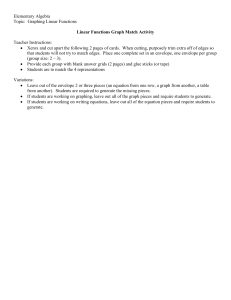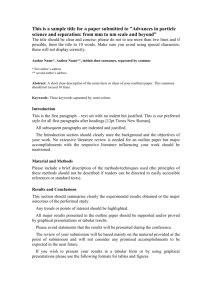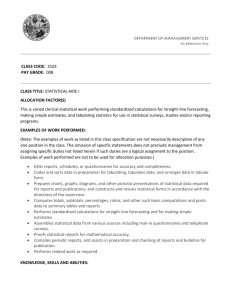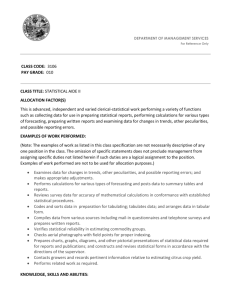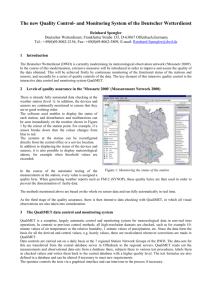DRIADE SURVEY: FINAL DRAFT - The Dryad data repository wiki
advertisement
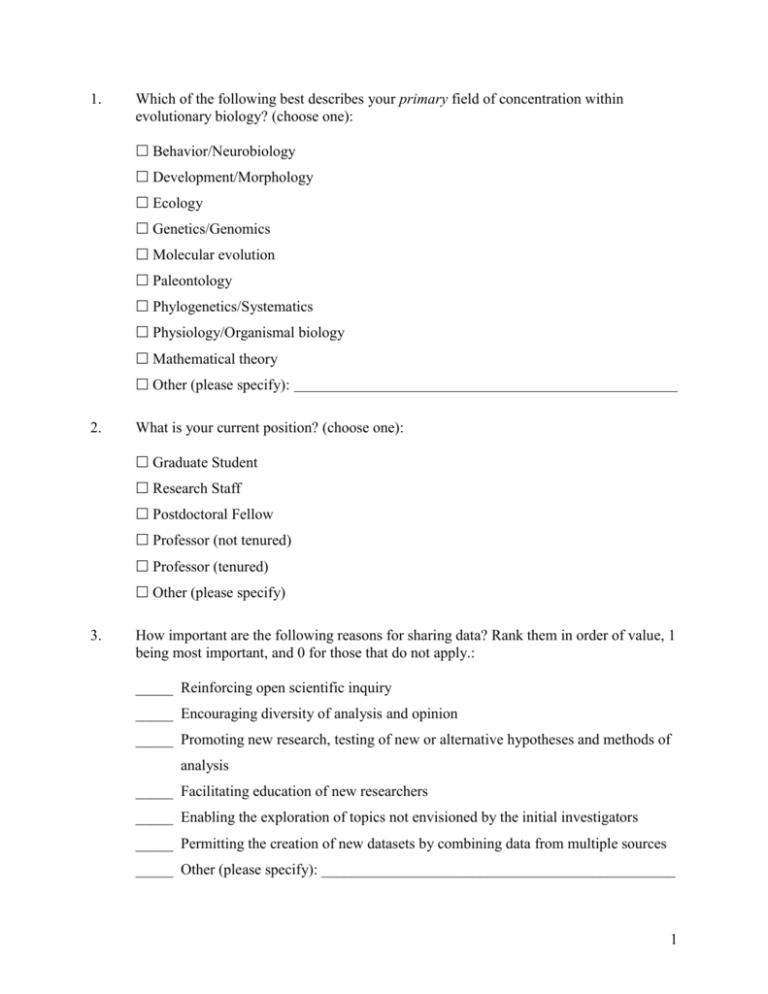
1. Which of the following best describes your primary field of concentration within evolutionary biology? (choose one): Behavior/Neurobiology Development/Morphology Ecology Genetics/Genomics Molecular evolution Paleontology Phylogenetics/Systematics Physiology/Organismal biology Mathematical theory Other (please specify): 2. What is your current position? (choose one): Graduate Student Research Staff Postdoctoral Fellow Professor (not tenured) Professor (tenured) Other (please specify) 3. How important are the following reasons for sharing data? Rank them in order of value, 1 being most important, and 0 for those that do not apply.: _____ Reinforcing open scientific inquiry _____ Encouraging diversity of analysis and opinion _____ Promoting new research, testing of new or alternative hypotheses and methods of analysis _____ Facilitating education of new researchers _____ Enabling the exploration of topics not envisioned by the initial investigators _____ Permitting the creation of new datasets by combining data from multiple sources _____ Other (please specify): _______________________________________________ 1 4. Do you think the data underlying published scientific results should be made publicly accessible?: Yes 5. If you answered yes to the above question, do you think journals should require data sharing of their authors, or should it be voluntary? : Required 6. No (If “no,” please skip to question 6) Voluntary Valuable research data is sometimes lost or discarded due to inadequate preservation or distribution by the author/s. How concerned are you that this loss of data has a negative impact on your field?: Very concerned Somewhat concerned Slightly concerned Neutral I am not concerned 7. What kinds of data records do you have? Rank them in order of volume from most to least important, 1 being most important, and 0 for those that are not relevant to you.: _____ 2D Images (including maps) _____ 3D images _____ Experimental data (in tabular form), not including pedigree data _____ Individual observations, such as behavioral data (in tabular form) _____ Pedigree data (genotypic and/or phenotypic data) _____ Free-form text (e.g., field observations, specimen descriptions) _____ Biomolecular structures _____ DNA, RNA or protein sequences (unaligned) _____ Gene expression data _____ Phylogenetic data matrices and sequence alignments _____ Population-based observations, such as allele frequencies (in tabular form) _____ Geographic data (multiple localities, not including map images) _____ Environmental observations (from one locality, in tabular form) _____ Movies (with or without sound) 2 _____ Sound files _____ Mathemetical model results (in tabular form) _____ Stratigraphic data (in tabular form) _____ Other (please specify): Are these data tabular? YES NO _____ Other (please specify): Are these data tabular? YES NO _____ Other (please specify): Are these data tabular? YES 8. NO Which of these kinds of data records do you not share with others? (select all that apply): 2D Images (including maps) 3D images Experimental data (in tabular form), not including pedigree data Individual observations, such as behavioral data (in tabular form) Pedigree data (genotypic and/or phenotypic data) Free-form text (e.g., field observations, specimen descriptions) Biomolecular structures DNA, RNA or protein sequences (unaligned) Gene expression data Phylogenetic data matrices and sequence alignments Population-based observations, such as allele frequencies (in tabular form) Geographic data (multiple localities, not including map images) Environmental observations (from one locality, in tabular form) Movies (with or without sound) Sound files Mathemetical model results (in tabular form) Stratigraphic data (in tabular form) Other (please specify): Are these data tabular? YES NO 3 Other (please specify): Are these data tabular? YES NO Other (please specify): Are these data tabular? YES 9. NO Approximately how much of your data is stored digitally/electronically, in percentage of importance to your overall data collection? (choose one): none less than 25% 25% - 50% 51% - 75% more than 75% 10. If you have reused previously published data (of your own or others), how old was that data at the time of reuse? (Please choose one. If multiple answers are possible, please choose the oldest.): I have never reused published data Less than 1 Year 1-3 Years 3-5 Years 5-10 Years More than 10 Years 11. Rank your preferred methods of providing your data to others using a 1 thru 5 scale, 1 being most preferred, and 0 for those that do not apply: _____ My lab or personal website _____ Supplemental materials (hosted by journal/publisher/society website) _____ Correspondence _____ Submission to a database _____ Other (please specify): 12. Which of the following online repositories or databases have you used to deposit research data? (check all that apply): 4 I have not deposited research data into any repositories/online databases Sequences: e.g. Genbank/EMBL/DDBJ Polymorphisms: e.g. dbSNP Images, character matrices: e.g. Morphbank, MorphoBank, DigiMorph Microarray data: e.g. GEO, ArrayExpress, SMD Ecological data: e.g. Metacat/KNB Genomic model organism data: e.g. SGD, ZFIN, FlyBase, WormBase, MGD Paeleontology data: e.g. PaleoBiology Database Phylogenetic trees, character matrices: e.g. TreeBASE, Tolkin Other (please specify type/name): 13. When you last deposited data in a publicly accessible repository, by whom were you required to do so? (choose one): I have never deposited data in a repository or online database I was not required to deposit my data Boss/Employer Grant/funding source Collaborators Other (please explain): 14. In general, at what point do your deposited data become publicly accessible? (choose one): I do not deposit research data At the time data is collected Prior to paper submission At the time of paper submission At the time of paper acceptance or publication After paper publication Other (please specify): 15. In the past five years, have you been unable to recover your own data that you would have liked to have reused or shared?: 5 I have never unintentionally been unable to recover data On one occasion On more than one occasion 16. For what approximate percentage of your published work do you still have access to the original data in usable form?: none less than 25% 25% - 50% 51% - 75% more than 75% 17. In the past five years, how often have you received requests to share data from your published works?: 0 times 1-3 times 4-6 times more than 6 times 18. Of the data sharing requests that you have received, approximately what percentage of requests have you granted?: I have not received any data sharing requests none less than 25% 25% - 50% 51% - 75% more than 75% 19. For the requests that you have granted in the past, what conditions, if any, did you attach?: I did not attach any conditions Credit by acknowledgment 6 Credit by citation Co-authorship Reciprocal sharing of the requestor’s data Submitting a joint grant application Other (please specify): 20. For the requests that you have NOT granted in the past, why did you choose not to share your data? Rank the following choices, 1 being most common, and 0 for those that do not apply.: _____ Lack of acknowledgment by requestor _____ Lack of adequate credentials of requestor _____ Technological constraints _____ Legal constraints _____ To protect the ability to publish additional findings at a later date _____ Too much effort required to locate data _____ Too much effort required to adequately organize/document data _____ Other (please specify): 21. In the past five years, how many times have you requested data from other authors/researchers?: I have not requested data from other authors/researchers 1-3 times 4-6 times more than 6 times 22. In the past five years, how many of your data requests made to other authors/researchers have been granted? I do not request data from other authors/researchers none less than 25% 25% - 50% 51% - 75% 7 more than 75% 23. How many of your publications in the past five years have used a substantial amount of data obtained from public repositories or otherwise acquired from other research groups?: None less than 25% 25% - 50% 51% - 75% more than 75% 24. Please indicate how you have acknowledged data producers from outside your research group. Rank the following choices, 1 being most common, and 0 for those that do not apply.: _____ I have never combined my research data _____ Acknowledgment _____ Citation of publication _____ Other form of citation (e.g., to a database record) _____ Made them co-author(s) _____ Started follow-up collaboration resulting in at least one co-authored publication _____ Submitted a joint grant application _____ Other (please specify): 8
